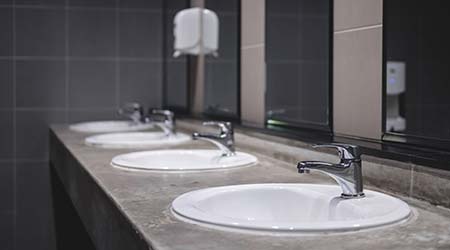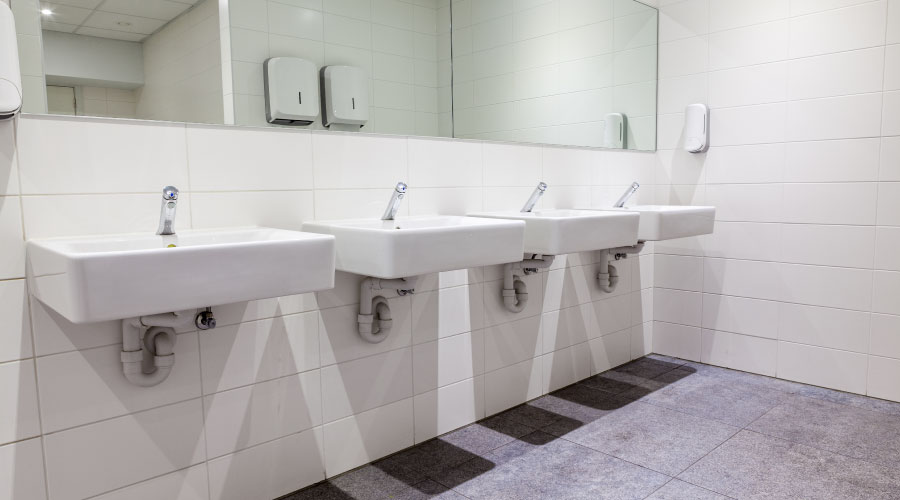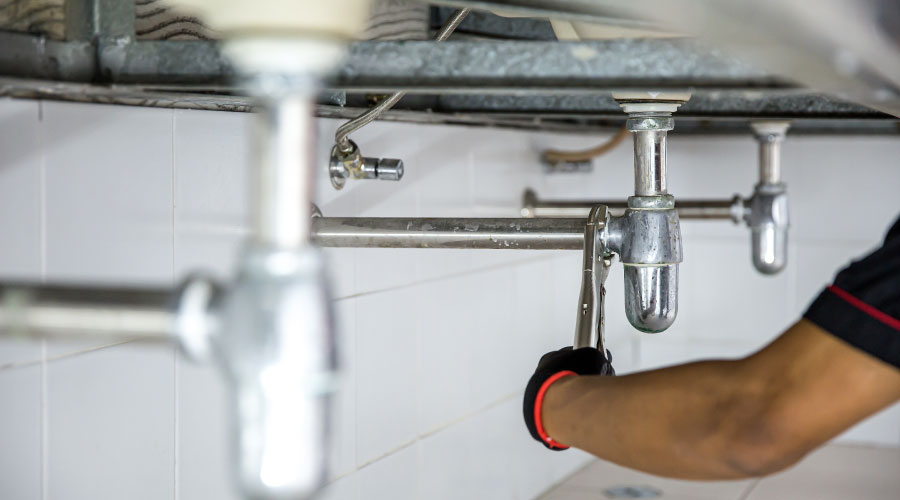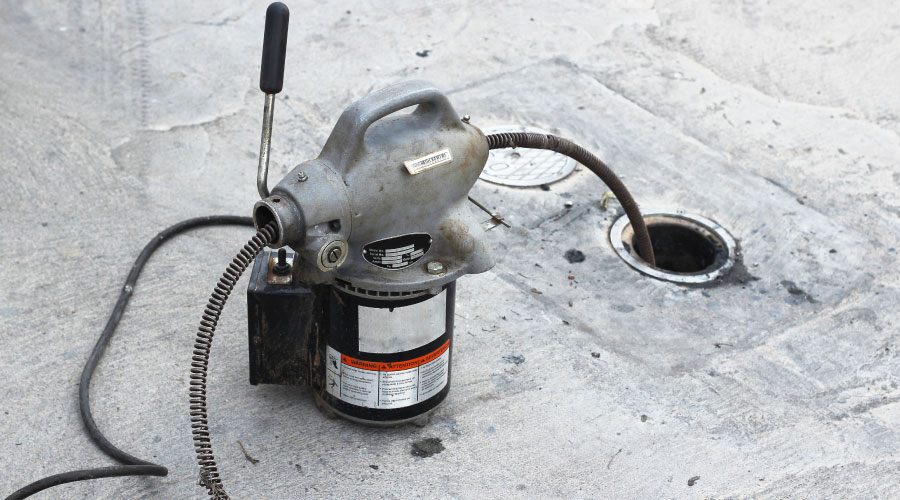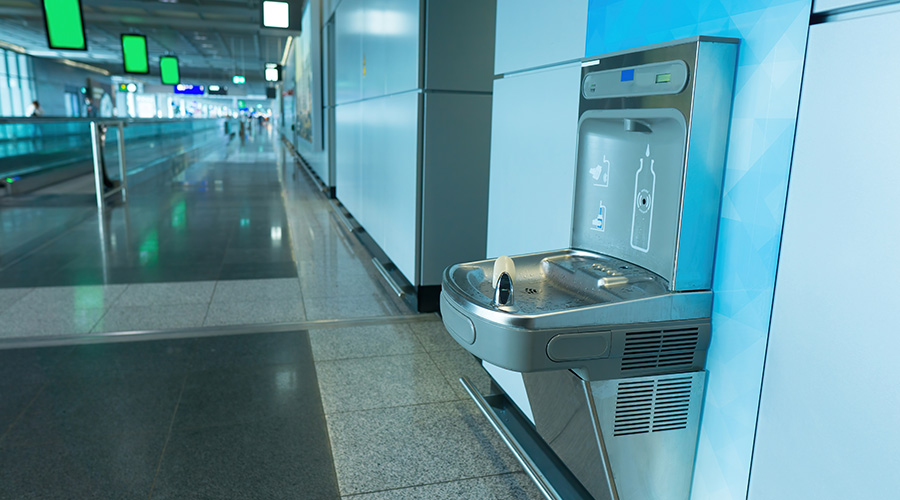3 Restroom Complaints and How to Prevent Them
Don’t let your restroom get a bad rap for being stinky, dirty, or out of supplies.
Odors. Cleanliness. Supplies. These are among the most common complaints that facility managers receive pertaining to their restrooms. What can be done to address them? In new facilities, the restroom design should be focused on measures to avoid these issues. In existing facilities, facility managers can take steps to minimize their impact on operations. Here’s a close look at ways to prevent these common complaints.
1. Preventing Odors
It has been said that odors in a restroom are the result of the lack of cleaning and that a properly cleaned restroom will have no odor issues. While that may be true in many cases, it is not always true. In some instances, restrooms may be on a suitable cleaning schedule using the correct equipment and cleaning supplies, and still odor is an issue. In these cases, it is important for facility managers to identify the source of the odor that occupants are complaining about before making any changes to their cleaning schedules or activities.
For example, urine may have penetrated unsealed grout. Conventional cleaning methods may not be sufficient to remove it or the odor from the restroom. Regularly scheduled cleaning with a steam cleaner or a spray and vac system specifically designed for the type of flooring installed in the restroom may help to remove the urine from the grout and eliminate the odor. If that is successful, then all wall and floor grout should be sealed once it has been cleaned to prevent further absorption.
Dry traps are another common source of odor that leads to complaints about restrooms. Traps are designed to hold a small volume of water to prevent sewer gasses from entering a space from the drain/waste system. While urinal and water closet traps rarely go dry, floor drains do. Even with the wet mopping of flooring, there may not be sufficient water entering the drain to recharge the trap. Make it a practice to have cleaning personnel add one gallon of water to each floor drain every time the restroom is cleaned.
Inadequate ventilation is also a frequent cause of restroom odors. Even with clean and well-maintained restrooms, complaint-generating odors will build up unless there is a constant flow of ventilation air. Restroom exhaust fans generally are ignored when it comes to maintenance, unless someone reports that they are not operating. But even if the fan is running, it may not be moving sufficient air to do the job. Exhaust systems can be undersized. Dust, dirt, and lint can easily clog vent ducts and vent covers, restricting the flow of air. At least once each month, restroom exhaust systems should be inspected and cleaned as necessary. If cleaning does not solve the problem, have the maintenance department determine the flow rate for the exhaust system and see if it measures up recommended rates.
2. Keep It Clean
Cleanliness is one of those subjective measures that cannot be easily quantified. It may be that the restroom really is dirty, or it may be that the restroom is clean and sanitary but just creates the impression of not being clean. If you are receiving general complaints about cleanliness, follow up to determine exactly what people are complaining about. There are many causes and perceptions that can lead occupants to complain that the restroom is not clean.
If there is visible dirt on the floors and other surfaces, adjustments will have to be made to cleaning frequencies, methods, or both. Perhaps the level of use of the restroom is higher than anticipated when the cleaning schedule was established. Maybe the quality of the cleaning product or equipment is too low to do the job well enough to prevent complaints. It could even be that cleaning personnel are making mistakes in performing their duties. Talk to those who are performing the tasks and get their opinions on what is going wrong. It may be necessary to upgrade the existing cleaning products or even to invest in new cleaning equipment such as steam cleaners.
Another common source of complaints concerning cleanliness is the result of overflowing trash receptacles. Overflowing trash receptacles is not necessarily an indication that the restroom is not clean, but it is often perceived that way and can lead to complaints. If receptacles are overflowing, facility managers have a couple of options. They can increase the frequency with which the receptacles are emptied. They can increase the number or the size of the receptacles. They can replace the existing paper towel dispensers with ones that can be adjusted to limit the amount of product dispensed per use. They can replace some or all of the paper towel dispensers with electric hand dryers. Each option will help prevent complaints. Facility managers just need to select the step or steps most appropriate for their application.
The proper placement of equipment in the restroom will help with traffic flow, particularly in high use facilities, and will also assist facility managers in avoiding cleanliness complaints. For example, placing paper towel dispensers and electric hand dryers in a direct line between the sinks and the restroom exit speeds traffic flow and limits the quantity of water that drips onto the floor.
In new facilities, all flooring should be installed with an adequate slope towards floor drains for fast runoff of floor-cleaning liquids. When possible, fixtures should be wall-mounted and partitions wall- and ceiling-mounted to make it easier to clean the floors. One exception to this is those facilities where there is a high potential for vandalism.
Using light color countertops can also help to prevent complaints about cleanliness. Darker countertops tend to show water spots more clearly, something that translates into a perception of the counter being unclean. Similarly, highly polished finishes on fixtures require more frequent cleaning to remove water spots and dirt smudges.
Essentially, the goal is to install fixtures and finishes that will allow cleaning personnel to achieve the desired level of cleanliness and appearance with a minimum level of labor.
3. Don’t Run Out of Supplies
If lack of cleanliness is the most common complaint, then running out of supplies is a close second. Occupant frustration peaks when they find soap, tissue, or paper towel dispensers empty. The cause can be as simple as lack of attention to detail or improper scheduling of service.
There are several steps that facility managers can take to minimize outages of supplies and resulting complaints. The installation of high capacity fixtures decreases the chances of running out of materials, while cutting labor costs by reducing the number of times that the staff must refill the dispensers.
It might sound wasteful to implementing a policy to require that, when the restroom is serviced, the remainder rolls of paper towels and toilet tissue are to be replaced, but such a step will help prevent instances where occupants complain that the restroom has run out of product. Remainder rolls can be used for other functions by cleaning personnel.
Keeping adequate supplies in the restroom also means that facility managers should set up a system where product is stored in reasonable amounts close by. If cleaning personnel must spend time traveling to a distant location to get those supplies, time and money will be wasted. Supplies that are difficult to obtain won’t be.
All restrooms should be inspected on a regular basis for things like cleanliness. That inspection should go beyond appearances. Each fixture, from sinks to water closets, should be tested for proper operation. Any leaks or valves that fail to properly should be noted and work orders generated. By taking these actions, facility managers can help to ensure that the health and safety of building occupants and visitors is maintained at a high level. Equally important, they will find that the number of complaints that they receive will be significantly reduced.
James Piper, PhD, PE, is a writer and consultant who has more than 35 years of experience in facilities management. He is a contributing editor for Building Operating Management.
Related Topics:








